For instance, if I have a 24VDC/10A relay would running significantly less current (say 12VDC/2A) through it cause it to not operate properly?
-
5You can run lower voltage or current through the switched arm, but you need to provide the coil whatever voltage & current the datasheet calls for. – The Photon Dec 27 '12 at 04:11
-
Thanks. Makes sense. Max is the rating and the minimum is determined by the coil. – Kevin Mark Dec 27 '12 at 04:12
-
2you're missing my point (also covered in the answers you've gotten). The switched arm is totally different from the coil arm in how the ratings apply. A datasheet link for the relay you're using would help make this more clear. – The Photon Dec 27 '12 at 04:14
-
The coil *has a* minimum rating for the required voltage. The switched arm *has a* maximum rating for the switched current. – The Photon Dec 27 '12 at 04:18
-
I apologize for the ambiguity, thanks for explaining the differences. – Kevin Mark Dec 27 '12 at 04:19
-
1See comments in one answer re wetting current. Too low a current may not break down contact oxidation. Sometimes a minimum open circuit voltage is specified - usually above about 10V will result in OK operation. – Russell McMahon Dec 27 '12 at 05:06
-
SOMNE spec sheets allow both oprate and hold in currents and voltages to be determined. Some give "must operate" (Vin_min) and will not operate (Voff max) figures for coil. Note also that AC and DC contact ratings vary substantially and that resistove, capacitive and inductive loads affect result. As too can power factor (mix of RLC). – Russell McMahon Dec 27 '12 at 05:08
3 Answers
For the actual contacts, it's a good idea to provide a minimum wetting current to maintain good contact (the datasheet will sometimes specify a minimum load current). Other than that you can run them at whatever current you like under the maximum value (10A in your example)
The coil should be driven at it's specified rating (24V in the example you link to)
Reference on switch contacts
Reference 2
You should really make sure that your relay has a decent datasheet that provides enough info - the one you link does not appear to have one, so I'd avoid it (unless you can google the part number and get it elsewhere)
Here are examples of the contact and coil ratings from a typical datasheet (in the contact section, note the minimum switching load and the different maximum switching ratings for AC/DC):
Contact Ratings:

Coil Ratings (note the release voltage is much less than the operate voltage - once the relay has switched, it takes less power to keep it in position):

- 54,990
- 3
- 76
- 147
Varies by manufacturer and device. You would need to look at the datasheet for the relay to see if it is within range. By drastically underpowering a relay, you risk not triggering the internal magnetic coil.
Normally though, a relay stated as 24v/10A, would mean it is triggered by 24v on it's coil pins, and rated to carry 10A on it's nc/no pins. The 10A would not be it's relay trigger current, though there are industrial relays that can take that much.
- 72,580
- 7
- 90
- 202
If you are referring to the ratings for for the load (switching) path in the relay, you may run under the maximum current and voltage ratings with no problem.
If you are referring to the coil specifications, you must provide enough voltage to actuate the coil; this is often refered to as the "pickup voltage" specification.
- 2,832
- 18
- 23
-
So, to use [this](http://www.radioshack.com/product/index.jsp?productId=12491826&filterName=Type&filterValue=DPDT#) relay as an example (same rating as the OP) I'm free to use anything under 10A but it must be 24V? – Kevin Mark Dec 27 '12 at 04:09
-
3That relay has a coil resistance of 650 ohms. I = V/R, 24/650 = 0.0356, you only need 36 milliamps to trigger the relay. And it's datasheet http://www.nteinc.com/relay_web/pdf/R14.pdf shows it should trigger at 75% of nominal (24v) voltage, so atleast 18v. – Passerby Dec 27 '12 at 04:15
-
3@KevinMark, never buy a component without a proper data sheet. The data on the distributor (Radio Shack) website is not reliable. The data sheet for this part number is here: http://www.nteinc.com/relay_web/pdf/R14.pdf – The Photon Dec 27 '12 at 04:17
-
1@passerby beat me to running the numbers and is absolutely correct. The coil requires >18V at about 40mA, while contacts can switch up to 2A. – B Pete Dec 27 '12 at 04:33